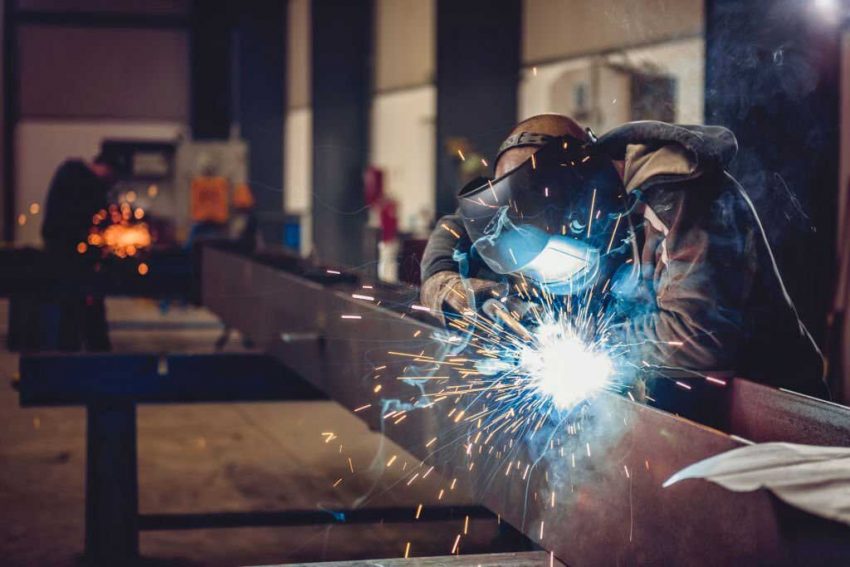Melting and joining 2 metal pieces using heat is an efficient way of fabricating or making repairs in metals. While welding methods are different, only a handful are widely used. MIG or metal inert gas welding is commonly used, especially for beginners.
MIG welding is relatively easy to learn compared to other welding methods such as TIG, stick, etc. Though, maintaining safety precautions is a must in all welding types.
This comprehensive guide explains the MIG welding process, why it is easy to learn, and other answers related to MIG welding.
Continue reading!
How Does MIG Welding Work?
Table of Contents
Using a welding gun, MIG welding creates an electric arc between a wire electrode and base metal. Thus, the metallic part gets heated, melted, and fused with other metals. During the process, the weld pool can contaminate. To avoid contaminations, a welding gun uses shielding gas, part of heated and melted metal.
You will find 2 types of MIG welding: automatic and semi-automatic.
In a semi-automatic MIG welder, the user manually controls the wire position and speed. But the arc length and wired feed rate.
Meanwhile, in automatic MIG welding, manual intervention by the user is totally unnecessary.
How Long Does MIG Welding Take to Learn?
MIG welding learning curves depend on a few factors of the welder: skill level, abilities, experience, and the provided instruction quality. Persons who know utmost little about welding will take as little as a few hours to learn MIG welding.
We advise beginners to enroll in an official welding school, college, certificate course, or training program. Remember not to attempt MIG welding if you don’t have the basics. Depending on the course schedule, MIG welding learning time may vary.
- An entire welding course may take 1 year to complete
- Basic welding course takes roughly 7 months to finish
- Fundamental classes of welding require 2 – 3 weeks to complete
- Additional welding programs may take a maximum of 1 month to complete
One important note to keep in mind is that learning any welding process will take more time than becoming a master. After gathering knowledge on the basics of the MIG welding process, a lot of practice is mandatory. In fact, the welding process is not an easy fish to fry; for some people, it takes several years to master. The proverb, “practice makes a man perfect” – perfectly matches the welding process.
Why is MIG Welding Popular?
Similar to all other welding processes, the advantages and disadvantages of MIG welding depend on the doer and the welding tools. Before investing valuable time, money, and effort in MIG welding, consider the pros and cons of this process.
Advantages:
MIG welding is easy to learn and most popular among all welding types for several good reasons. Some pros are given below.
- Productivity is high
- It takes less time to complete a project
- Manual adjustments are less
- During and after welding, requires little cleanup
- Effortless to work
- Straightforward process
- Easy Controlling
- Delivers clean outcome
- Versatile
- You can use it for all types of metals
- Creates fewer fumes
- Delivers premium-quality welds
- Needs less operator skill
Disadvantages:
Everything has disadvantages, and MIG welding is also no exception. If you don’t consider these disadvantages, MIG welding can become challenging to learn. Disadvantages include:
- Requires complex and expensive equipment
- Less portable
- It can’t be used for vertical or overhead projects
- Prone to contamination
- Light and radiated heat level is high
- Need a clean, rust-free metal
- Burning is common with thin metals
How to use a MIG Welder – 14 Easy Steps
Using a MIG welder, you can add a professional touch to welding. From the automotive sector to home repair, MIG welding is quite popular everywhere. In this section, we discussed how to use a MIG welder. Follow the steps meticulously.
We will be using stainless steel when accomplishing the MIG welding process in this section.
Required Materials:
- MIG Welder
- Welding clothes
- Wire for MIG welding
- Shielding gas
- Welding metal
- Air extraction
- Grinder (if required)
Step 01: Understand How MIG Welding Works
Understanding the process will help you use the MIG welder more professionally. You can work with stainless steel, aluminum, mild steel, etc. when you have a MIG welder in hand.
Step 02: Prepare for the Welding
Safety gear, including protective clothing, masks, gloves, is mandatory when MIG welding. Also, ensure that you are working in a well-ventilated area. To handle an emergency, keep a bucket of sand and CO2 near your hand.
Buying a comfortable MIG gun is also important. MIG guns come with pistol shape or acetylene looks. The machine size entirely depends on the project size.
Moreover, select a gun with water or air-cooled feature. Remove all flammable items from the welding area. Ensure the working surface is excellent and stable.
Step 03: Wire Installation
The welding material and wire type should be made of the same material. For instance, if you are welding stainless steel, the wire must also be made of stainless steel. Now, what would be the diameter of the wire? The general thumb rule is; thin wire for thin metals and thick wire for thick metals. A giant MIG welding machine may require thicker materials.
Step 04: Reel Preparation
The reel tension needs to be tightened. Otherwise, the wire may ravel due to its own tension. In order to avoid damage or tangle to the line feeder, keep the first 3” of the wire as much as straight. Trim the wire using a wire cutter.
Step 05: Feeding the Wire the Torch
Grab the wire and put it into the guide tube. Then, feed it over the roller. Next, insert it into the wire liner. If forcing is necessary, be sure the wire is misaligned.
- Make sure to choose a rust-free wire. It has a direct impact on the quality of the weld.
- After inserting the wire into the liner, press the switch of the welder. Push the wire through the welder by using the wire feed system.
Step 06: Tension Adjusting
Adjust the tension as required using the reel. For accuracy, check the reel and line feeder tension. The mountings may bend, and welding will damage due to too much tension. Ensure to maintain as much as minimum tension.
Step 07: Start Welding
The welding machine needs to be set on the reverse polarity DCEP.
Step 08: Consistent Length of the Electrode is a Must
While welding, maintain the electrode length within ¼” and 3/8. This length requires it to be kept from the contact tube. Thus, you will get an efficient and clean weld.
Step 09: Choose the Right Shielding Gas
Since welding stainless steel, CO2 would be the ideal choice as a shielding gas. This way, steel will get deeper penetration.
Here is the answer if you think about shielding gas to use with other metals.
- For aluminum, use argon.
- For thinner steel, use a mixture of argon (75%) and CO2 (25%)
Step 10: Follow Push or Drag Welding Technique to Weld
Hold the gun at a 10° angle. Also, at the front corner of the weld pool. Both positioning will ensure better control.
- For a narrower bread and deeper penetration, drag welding pulls the bead along the tip.
- For more comprehensive bread, push welding pushes the bead with the tip.
Step 11: Flat Weld Making
You can achieve a flat weld by holding the welder at a 90° angle. For filling more significant gaps, the back-and-forth method is beneficial.
Step 12: Horizontal Weld Making
Slightly lower the welder angle for making horizontal welding. Apply the back and forth weave method in this case to get a better result.
Step 13: Vertical Weld Making
While welding thin metals, start welding from the top. Then move down with gravity. As a result, the arc will not penetrate deeply. On the other hand, thicker metals start welding from the base. Then go up. This way, penetration will increase.
In this step, you may fight against gravity. Keep the amperage between 10-15%.
Step 14: Complete the Weld
Grind off the additional filler after completing the welding process. If you find a defective result, grind it down. Then, re-weld the joint.
What to Know When Learning MIG Welding?
Understanding some basics is necessary when learning MIG welding. MIG is a type of ARC welding, and 3 other common welding types are:
- Gas Tungsten ARC Welding (GTAW/TIG)
- Shielded Metal ARC Welding (SMAW/Stick)
- Flux-cored ARC welding (FCAW/Flux)
Tips, Advice & Safety
- Follow the MIG welding process in a dry environment.
- Selecting the right shielding gas is significantly essential; check the owner’s manual to learn which shielding gas pairs well with which material.
- Machine settings adjustment needs to be done according to the project type and metal size.
- Always choose a clean, dust and rust-free metal for MIG welding.
- Work in a well-ventilated, smooth and stable area
- Keep the working area and other equipment dry to avoid electric shock.
- Keep in mind the power requirement and duty cycle of your selected material.
FAQ
What is the hardest type of welding?
Among the 4 different types of welding, GTAW/TIG is the hardest to learn. For the below reasons, it is the hardest:
- Operators need to perform several tasks like welding, gas cooling, heat level controlling, etc. at the same time
- Relatively slow process than other welding types
Is MIG welding suitable for beginners?
MIG welding is the easiest to learn and doesn’t require previous experience. Only a few hours of practice are required to start MIG welding. So, if you are a beginner and want to build your career as a welder, start with MIG welding.
When should you MIG Weld?
MIG welding is suitable for large and thicker materials. It works as a consumable wire that performs as both the filler material and the electrode.
Wrapping Up
Hopefully, you got the answer to the question, is MIG welding easy to learn.
Out of several welding methods, MIG welding is the easiest to learn. Although the required equipment is costlier than other welding methods, the ease of use and quality weld makes it popular among professionals and beginners.
The learning curve of MIG weld is comparatively short for those who have basic welding knowledge. Even beginners can learn it with a bit of practice. However, we always advise practicing a lot and admitting to a certification course to master MIG welding.

